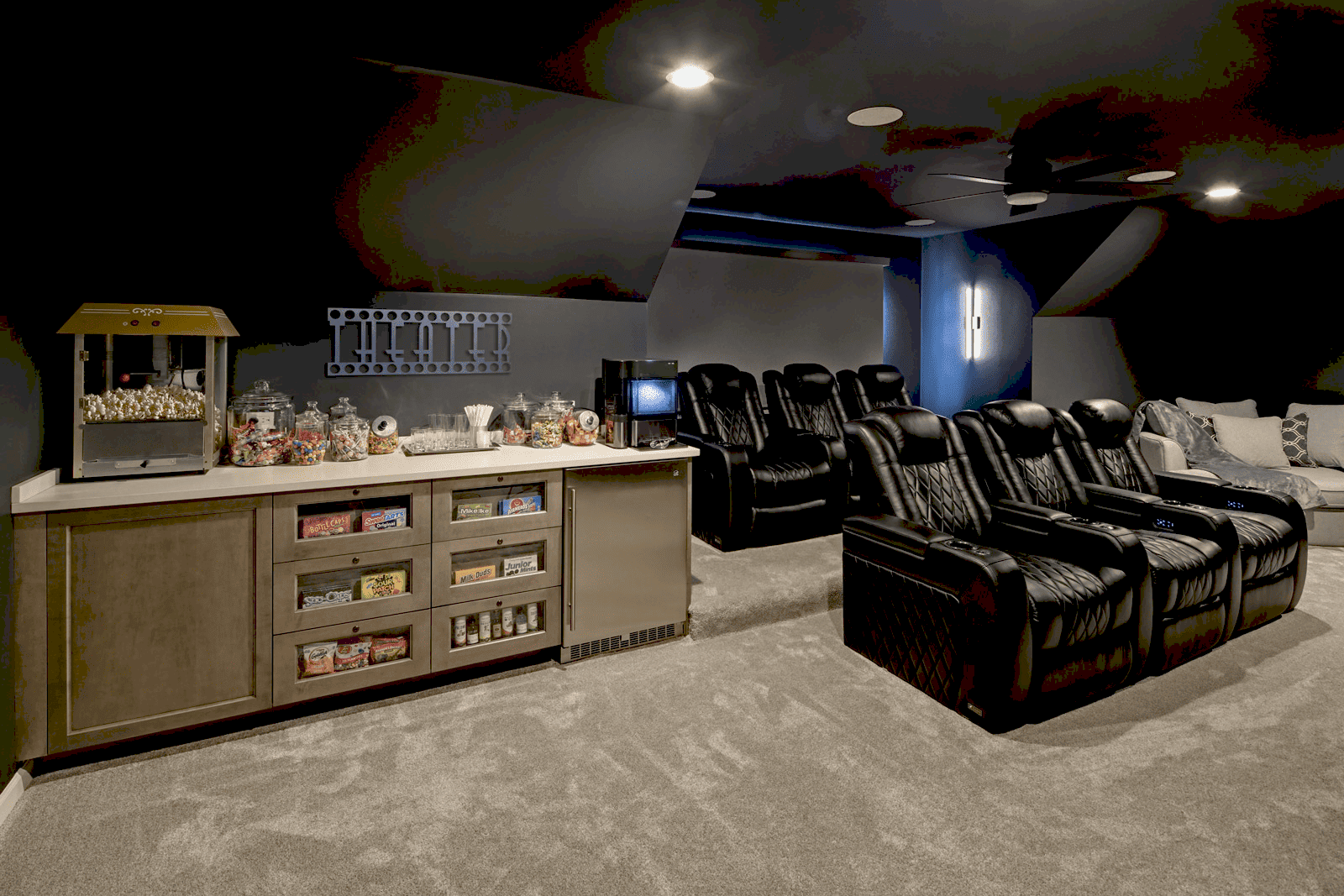Creating a home theater involves careful selection of TV, projectors, sound systems, and decor to replicate a cinema-like atmosphere. Essential elements include choosing the right lighting, utilizing budget-friendly equipment, and understanding key technologies such as 4K and HDR. By focusing on these aspects, you can craft a captivating home theater experience.
Choosing the Right TV: Factors to Consider
Home theater setup begins with the right television. Selecting a TV can be overwhelming due to the numerous options available. Here are key factors to consider:
- Size: Measure your space and determine the optimal screen size. A common recommendation is to sit at a distance 1.5 to 2.5 times the diagonal size of the TV.
- Resolution: For a home theater, 4K resolution is ideal, offering four times the detail of 1080p. This enhances the viewing experience significantly.
- Display Technology: Choose between OLED and LED. OLEDs provide deeper blacks and better contrast, while LEDs are generally brighter.
- HDR (High Dynamic Range): Look for HDR compatibility for better color accuracy and contrast. It makes images more lifelike.
- Smart Features: Ensure your TV has built-in streaming apps for convenience. Most modern TVs offer these features.
When choosing a TV for your home theater, also consider your budget and the technologies that meet your needs. The right TV enhances your home theater setup, making movie nights more enjoyable.
Best Projectors for Home Use: Which One Fits You?
Projectors can transform your living space into a cinematic experience. Here are some of the best projectors for home use:
- Epson Home Cinema 2150: Known for its bright image and wireless capabilities, this projector is perfect for family movie nights.
- BenQ HT2050A: This projector offers excellent color accuracy and low latency, making it ideal for gaming and movies.
- Optoma HD146X: A budget-friendly option that doesn’t compromise on quality, great for watching sports and movies.
When selecting a projector, consider the following:
- Brightness: Measured in lumens, a brighter projector is necessary for well-lit rooms.
- Resolution: Look for at least 1080p for clear images. 4K projectors are available but can be pricier.
- Throw Distance: Ensure the projector fits your room size; some require more space to project larger images.
Ultimately, the best projector for your home use depends on your specific needs and budget. With the right choice, you can enjoy a theater-like experience in your own home.
Understanding Video and Audio Formats for Home Theater
To enhance your home theater setup, understanding video and audio formats is crucial. Here’s a breakdown:
- Video Formats: Common formats include MP4, MKV, and AVI. MP4 is widely supported, making it a safe choice for most users.
- Audio Formats: Dolby Digital, DTS, and PCM are essential for high-quality sound. Dolby Atmos provides an immersive audio experience, ideal for modern home theaters.
- Streaming Formats: Check compatibility with streaming services. Most platforms use H.264 or H.265 for video compression.
To ensure optimal performance, match your media formats with your devices. For instance, if you have a 4K TV, ensure your content is also in 4K to fully utilize its capabilities. Investing in quality formats enhances both video and audio, creating a captivating home theater experience.
Sound Setup for Home Theater: Tips and Tricks
Sound setup for home theater is crucial for creating an immersive viewing experience. Poor sound quality can ruin even the best visuals. Here are some tips to enhance your sound setup:
- Speaker Placement: Position your speakers for optimal sound distribution. Front speakers should be at ear level, while subwoofers can be placed in corners for better bass response.
- Surround Sound: Consider a surround sound system for a more engaging experience. A 5.1 or 7.1 system can envelop you in sound, making you feel part of the action.
- Calibration: Use calibration tools or built-in features in your receiver to adjust speaker levels and distances. This ensures sound is balanced and clear.
- Acoustic Treatment: Soft furnishings can help absorb sound and reduce echo. Consider adding rugs, curtains, or acoustic panels to improve sound quality.
- Sound Formats: Invest in sound systems that support Dolby Atmos or DTS:X for a more dynamic audio experience. These formats allow sound to move in three-dimensional space.
By prioritizing sound setup, you can significantly enhance your home theater experience. The right audio can turn an ordinary movie night into a captivating event.
Essential Cables and Accessories: What You Need
For your home theater setup, having the right cables and accessories is essential for seamless connectivity and optimal performance. Here’s what you need:
- HDMI Cables: These are crucial for connecting your TV, projector, and audio systems. Look for high-speed HDMI cables to support 4K and HDR content.
- Optical Cables: Use these for connecting your soundbar or AV receiver to your TV for high-quality audio transfer.
- Speaker Wire: If you have a wired sound system, ensure you have the appropriate gauge speaker wire to connect your speakers effectively.
- Power Strips and Surge Protectors: Protect your equipment from power surges and have enough outlets for all devices with a reliable power strip or surge protector.
- Remote Controls and Smart Hubs: Consider universal remotes or smart hubs for easy control of multiple devices. This simplifies the user experience and enhances convenience.
Choosing the right cables and accessories can make a significant difference in your home theater setup. Investing in quality products ensures reliable performance and a better viewing experience.
Furniture Arrangement for Optimal Viewing Experience
Furniture arrangement plays a vital role in achieving the best viewing experience in your home theater. Here are some tips to consider:
- Screen Position: The screen should be at eye level when seated. This prevents neck strain and improves comfort during long viewing sessions.
- Seating Distance: Maintain a distance of 1.5 to 2.5 times the screen size for optimal viewing. This ensures you can enjoy details without straining your eyes.
- Seating Layout: Arrange seating in a way that allows everyone to have a clear view of the screen. Consider a tiered seating arrangement for larger rooms.
- Accessibility: Ensure that pathways are clear and seating is easily accessible. This enhances comfort and safety for all viewers.
- Lighting Considerations: Position your furniture to minimize glare from windows or lights. Use curtains or blinds to control natural light effectively.
By thoughtfully arranging your furniture, you can create a comfortable and enjoyable environment for movie nights, enhancing the overall home theater experience.
Creating a Theater Atmosphere at Home: Lighting and Decor
Creating a theater atmosphere at home is essential for enhancing your viewing experience. The right lighting and decor can make your home theater feel like a real cinema. Here are some tips to achieve that:
- Lighting: Use dimmable lights to control the brightness according to your movie. Consider installing LED strip lights behind your screen or around the room for ambient lighting.
- Blackout Curtains: Install blackout curtains to block out natural light. This creates a dark environment, which is crucial for viewing movies without distractions.
- Wall Colors: Choose dark colors for your walls to minimize reflections. Darker shades absorb light, enhancing your viewing experience.
- Decor Elements: Add movie posters, themed decor, or comfortable seating to replicate a cinema vibe. A popcorn machine can also add to the ambiance, making movie nights more fun.
- Acoustic Panels: Consider adding acoustic panels to your walls to improve sound quality and reduce echo, creating a more immersive experience.
By focusing on these elements, you can transform your space into a cozy, cinema-like environment that elevates your home theater experience.
Budget Equipment for Home Theater: Quality on a Budget
When setting up a home theater, budget equipment can still deliver a great experience without breaking the bank. Here’s how to find quality options:
- Research: Look for reviews and comparisons of budget-friendly TVs, projectors, and sound systems. Websites like CNET and TechRadar offer valuable insights.
- Refurbished Products: Consider purchasing refurbished models. These products are often significantly discounted and tested for quality.
- Sales and Discounts: Keep an eye out for sales during holidays or events like Black Friday. You can find significant discounts on home theater equipment.
- Entry-Level Options: Brands like Vizio and TCL offer affordable TVs with good quality. For sound systems, consider options from brands like Polk Audio or Yamaha that provide great value for money.
- DIY Solutions: You can create your own acoustic panels or build your own projector screen to save money while enhancing your setup.
With careful selection and some creativity, you can assemble a fantastic home theater setup that fits your budget without compromising on quality.
Technologies to Consider When Buying a TV: 4K, HDR, and More
When investing in a new TV for your home theater, it’s crucial to understand the various technologies available. Here’s what to consider:
- 4K Resolution: 4K TVs provide four times the resolution of 1080p, offering stunning detail and clarity. This is especially important for larger screens.
- HDR (High Dynamic Range): HDR enhances contrast and color accuracy, making images appear more realistic. Look for TVs that support HDR10 or Dolby Vision for the best experience.
- Refresh Rate: A higher refresh rate (60Hz or above) provides smoother motion, which is essential for fast-paced action scenes.
- Smart Features: Most modern TVs come with built-in apps for streaming. Ensure your TV supports popular services like Netflix, Hulu, and Amazon Prime Video.
- Audio Technologies: Look for TVs that support advanced audio formats like Dolby Atmos for an immersive sound experience.
Understanding these technologies will help you choose a TV that meets your home theater needs, ensuring an enjoyable viewing experience for years to come.





